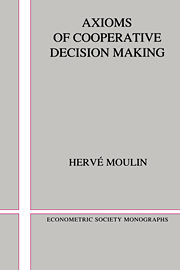9 - Majority voting and scoring methods
Published online by Cambridge University Press: 05 January 2013
Summary
Overview
“Democracy uses, as a method of governing, social summaries of citizens' decisions in elections and legislators' decisions in representative bodies” (Riker [1982], p. 21). Indeed, most public allocative decisions (such as taxes and public expenses) are made by voting. Elections are also used to fill many public offices. These are important examples of pure public goods (all citizens of a given town consume their mayor, with no possibility of exclusion) chosen by voting and precluding side payments.
Ever since the political philosophy of the Enlightenment, the choice of a voting rule has been a major ethical question with far-reaching implications on the behavior of most political institutions. The debate about fairness of various voting methods has been with us since the contributions of de Borda [1781] and Condorcet [1785]. In 1952, Arrow proposed the formal model that framed for three decades a voluminous mathematically oriented literature known as social choice (see Arrow [1963]). It studies the properties of various voting rules from an axiomatic angle. The object of Part IV is to discuss the most important contributions of the social choice approach.
Formally, a voting rule solves the collective decision problem where several individual agents (voters) must jointly choose one among several outcomes (also called candidates), about which their opinions conflict. In this chapter we assume that a finite set N of voters must pick one candidate within a finite set A (we discuss other options in Chapter 10). For simplicity we assume that individual opinions (or preferences) display no ties; they are arbitrary linear orders of A (i.e., complete, transitive, and asymmetric binary relations). This assumption entails no serious loss of generality.
- Type
- Chapter
- Information
- Axioms of Cooperative Decision Making , pp. 225 - 255Publisher: Cambridge University PressPrint publication year: 1988



